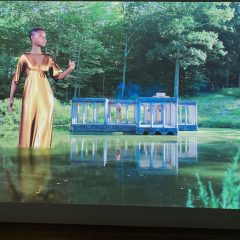The experience of art in a gallery requires spending sufficient time to allow the senses to be lifted into the world of the work on the walls surrounding you. Artists Isobel Sollenberg and John Gibbons (collectively known as Dechemia) have embraced this understanding of art viewing, designing their pieces like parts of an environment that welcome and threaten to swallow you whole as they beckon towards infinity, as though one were looking into an enchanted well.
Dechemia, which in Latin translates to “of chemistry,” are currently presenting new works in the show “Outside of Time,” up at Rebekah Templeton Contemporary Art in Fishtown through Dec. 22. In part inspired by the Mayan calendar and Philip K. Dick, the pieces in the show use concepts from sacred geometry and alchemy to depict a visual experience of the artists’ cosmology.
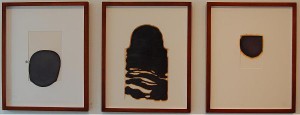
The symbolism of “sun-moon-stars” is partly cloaked in “Phobos,” “Epiphany: Father Time,” and “Deimos,” a triptych of pieces that ooze poured plaster out from archival mat board. The traditional presentation of the pieces makes their abstract visual language even starker. Rather than showing imagery or a pattern, dark matter seeps forth from these canvases, like a physical manifestation of the sublime or hidden quality of art.
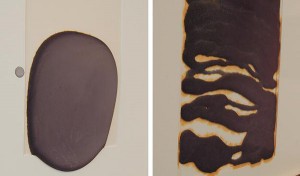
The rich, elemental appearance of the poured plaster resonates with the natural symbols the artists have incorporated into their work. The relation of the “sun” (Phobos) and “moon” (Deimos) culminates in a collision of opposites that forms the far richer and more textured central image, “Epiphany: Father Time.” With a vague outward glow at their edges, these shapes grow large in the mind’s eye as terrain for visual exploration.
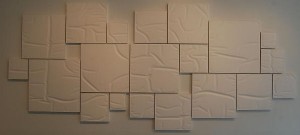
The centerpiece of the show, Outside of Time, “Milky Way 2012,” demonstrates Dechemia’s ability to create pattern in blankness. A mural-proportioned array of white poured-plaster blocks is the form across which softly-engraved lines conduct an organizing energy. The interlocking pattern is a delicate work, fragile enough to break apart, yet presented as an image of the human galaxy. The piece is nondescript and ambient, yet what may seem simple at first is far from it. Parts of the piece resembling wrinkles in a bed sheet may signify wrinkles in time. But each block, in its unique pattern of shallow-rut like depressions and varying size, is just one part of a complex, recursive pattern for the eye to play in.
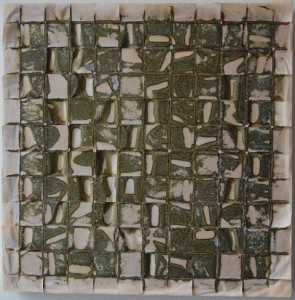
“Council” and “Increase” show the pair operating in a style they have previously explored: organic shapes out of grid-like rice paper patterns. These pieces remain unique from each other, and both reward close viewing. An assemblage of green — natural colors within a grid concentrated around concavities in the surface — “Council” almost resembles a depiction of cellular life. Look again and the absences of ink form bare letter-like shapes that articulate a nascent or diminishing order. If you focus on the rice paper that flutters loose at the edges of the piece, the entire grid becomes a delicately woven-together fabric. This combination of elements forms a whole which is harmonious in its disharmony, a composition that is unified by discordant, partly faded blotches of ink.
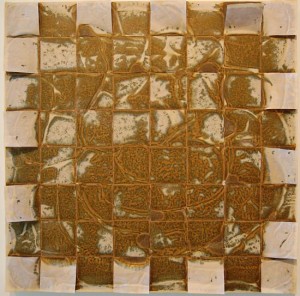
Taking a more confrontational stance, with a streaked spiral almost looming out of the canvas, “Increase” blends the ink to resemble sandy mud or wet dirt, in other words a landscape uncomfortable yet beautiful in its impurities. As the streaked central yellowish-brown line guides the eye around the rice-paper grid, it alternately loops or points to open-ended travel in the murk of the piece. The abstract representations in “Council” and “Increase” offer an imaginative journey for the eye and the mind.
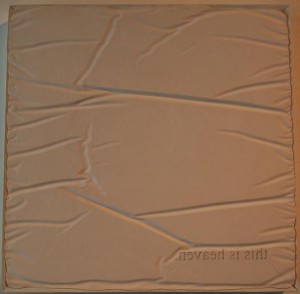
A smaller version of the same idea as “Milky Way 2012,” “This is Heaven” presents a white-on-white, line-folded piece of plaster and asks the viewer to embrace it as a representation of eternity and the afterlife.
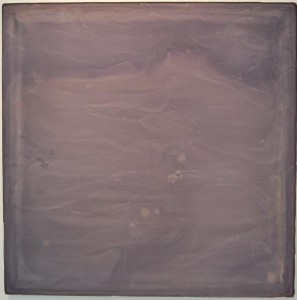
The other two pieces in the show, “Mirror Solve” and “Great Mother,” are washed-out compositions of ink over poured plaster. The layers of ink create a fog for the eye to play in, even as vague lines curl lazily like smoke lifting to the ceiling. The viewer is welcomed into “Mirror Solve” as either a puzzling mirror, exploring the vagueness of self-identification, or as a doorway into meditation of the piece’s illusory depth. “Great Mother” is a reduced version or reflection of “Mirror Solve,” like a closer, more simplified view of the strokes of ink that puzzle the viewer in “Mirror Solve.”
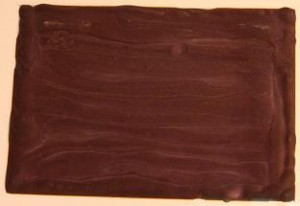
Dechemia write of their work that it forms itself around energy of transfers, “…revealing a path to the thoughts that allow dreaming and synchronistic revelations reflecting the eternal play of light and darkness.” Joining Dechemia on their trip Outside of Time, you can find your way to the magical freedom these pieces allude to.
Dechemia: Outside of Time will be up at Rebekah Templeton Contemporary Art through Dec. 22.



